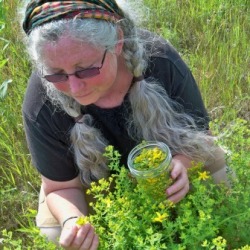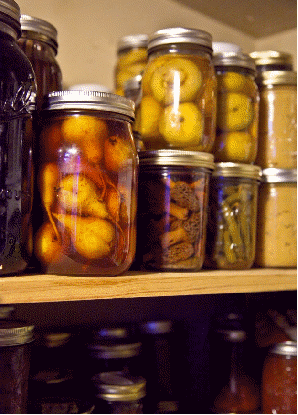I live in a cold climate, where the winter months can be quite long. Because fresh, local, wild food and herbs are not as readily in the winter months, I spend a lot of time during the fall months preparing food and medicine to have on hand for winter. As I harvest and put up winter stores, I ask what might I need for the upcoming months to keep myself, my family and my community healthy. Of course this is a multi-layered question, requiring a range of responses. Preparing requires planning as well as action. In order to prepare I start by brainstorming ways to stay healthy and strong as well as some of the winter ailments and issues that we have dealt with in the past. Below you will find a list of things you will find in our pantry as well as items found in our medicine chest. I hope these inspire you as you fill your pantry and medicine chest with nourishing food and herbal remedies.
The Pantry
Here a list of food items I like to have on hand so that we are stay healthy and strong. I am sure this list is not entirely complete, but it is the foundation for my winter food stores.
~Bones, lots of bones. We make bone broth quite often and either drink it or add it to the eternal winter stew pot. We also have venison and rabbit in the freezer, and the salmon our neighbor so generously shares with us, from their fishing trips.
~Green vegetables, I like to freeze vegetables and wild greens so that I can continue to eat local and wild greens throughout the winter. We also water bath can tomato sauce, adding wild greens and mushrooms as well as seaweed and herbal vinegar to increase the nutrient density of the sauce. I also lacto ferment many a vegetable including cabbage, carrots, beets, kalhrabi, green beans, brussel sprouts and many more. Over the years I have fermented almost every vegetable that has crossed my path.
~Root vegetables, I like to store these in cold storage for as long as possible so that they can be eaten fresh. Beets I like to put in a vinegar brine and water bath can so we can eat them throughout the winter. I also lactoferment them.
~Fruit, putting fruit and particularly berries in the freezer as well as canning them whole and in the form of sauces and jams and jellies. We also dry fruit either whole or in the form of fruit leather. Fruit leather is nice added in small pieces to homemade sourdough bread, but also just eating it is satisfying and most of all nourishing. One nice thing about canned fruit, is you can open it, put a tsp of whey in it and/or add a kefir culture, let it sit for a couple of days and you have fermented fruit, which is delicious and nutritious.
~Drying greens and herbs for later use. For making nourishing herbal infusions as well as for adding to the soup pot. We will dry throughout the year the wild salad greens that we do not finish fresh. We dry them on a screen or flat basket and then store them in the pantry. We dry a vast array of greens in the salad, and we dry nettle, oats, rosehips, comfrey, linden and mullein for our daily infusions.
~Drying nuts and storing them for winter is another important staple in our pantry. We dry black walnuts, hazelnuts and hickory nuts. We have a friend who sends us pecans and we enjoy them as well. These are added to many of our meals and I make a snack of soaked and toasted nuts, tossed with seaweed.
~While I do not always collect my own seaweed, since I no longer live on the west coast, I do like to have large quantities on hand. Seaweed can be added to whatever else you are cooking ie egg dishes, roasted vegetables, soup, stews, oatmeal, wild rice etc. Really in small pieces it adds salt to your food and you don't even know it is there….although the seaweed I like Nereocystis leutkeana is quite tasty and I have converted many a skeptical person into a seaweed enthusiast. If you would like to add seaweed to your stores you can order it from: http://www.ryandrum.com/IslandHerbsOrderForm2013.pdf
~Wild Rice, this is one of the biggest delights that has become a staple in my house since I moved to Wisconsin. Wild Rice is delicious nourishing and can be eaten for breakfast, lunch and dinner. It blends well with anything we eat and I like to have pounds of this on hand. This is true wild rice, not the patty grown wild rice, there is a big difference. If you would like to add wild rice to your stores you can find sources at this link: http://www.nativewildricecoalition.com/
The Medicine Cabinet
~Herbs for topical application. Dry skin, sore muscles as well as strains and sprains are things I like to be prepared for for the winter months. Infused oils are an important component of my medicine chest and I like to have Calendula (Calendula officinalis), Chickweed (Stellaria media), St Johnswort (Hypericum perforatum) , Comfrey (Symphytum officinale), Yarrow (Achillea millefolium), Cottonwood (Poplar sp) and Lavender (Lavendula officinalis) on hand. These herbs will help me in responding to many concerns including dry skin, inflammation, cold sores, sprains and strains and sore muscles (after shoveling snow).
~Herbs for internal applications. The medicine chest contains dry herbs for making infusions, which are in the pantry section, as we drink these daily. It also contains dry herbs that we many only enlist if we have symptoms ie fever, sore throat, cough etc. In addition, to dry herbs we like to have tinctures (alcohol extracts) on hand. Many of the herbs we put up in oil form, we also store as a tincture ie St Johnswort (Hypericum perforatum) , Yarrow (Achillea millefolium), Calendula (Calendula officinalis), Cottonwood (Poplar sp) and Chickweed (Stellaria media). Tinctures are nice as they can be accessed quickly and applied right away. We also put up in tincture form herbs that have an affinity for the immune system: two of these are Echinacea (Echinacea purpurea) and Bee Propopolis. We make many tinctures for many purposes, but these are staples that we often use during the winter months. We also make cough syrups, the simplest of which are oxymels.
~Locenges or Pastilles. We make these in a very simple form by using powdered herbs and our own honey. Slippery Elm (Ulmus rubra) and/or Marshmallow (Althaea officinalis) Root Works well. Ginger (Zingiber officinale) , Rose Petals (Rose sp) and orange peel (Citrus × sinensis) are wonderful herbs to add as well.
~An oxymel is just a sweet and sour herbal syrup. It contains: vinegar, honey & herbs. They're very beneficial for respiratory conditions, so the herbs contained therein will usually reflect that.
How to make an oxymel
~Fill a jar about half to three-fourths full of herbs.
~Pour the jar 1/3 with honey. Ideally this would be raw local honey.
~Fill the jar 2/3 or the rest of the way with vinegar OR for a sweeter syrup, try 1/2 jar honey and 1/2 jar vinegar. (I am using raw apple cider vinegar).
*the amounts that you use can be flexible. Both honey and vinegar act as preservatives, so you're not going to ruin the mixture by altering the ratios.
~Stir it all together; it might not blend well at first, but it will settle and blend over time. Just stir and or shake until it is blended. Then strain the herbs out, bottle it up and store in a cool place or the refrigerator.
Take oxymels by the spoonful for sore throats, thick congested coughs or as a general treatment to combat colds and flu.
Some herbs recommended for use in oxymels
*Elderberries (Sambucus sp): relieves flu symptoms, alleviates allergies, and boosting to overall respiratory and immune health
*Bee Balm (Monarda sp): eases a sore throat, antibacterial, relieves thick congested coughs as well as fever
*Elder flowers (Sambucus sp): specific for sore throats, immune stimulating and antiviral
*, Garlic & Onion: fights colds and flu, boosts immune health (it is suggested that these herbs are minced & that the mixture be refrigerated)
*Horseradish: opens the respiratory system and fights off infection.
*Mint, Ginger and/or fennel: stomach soothing, digestive aid
*Oregano: antibacterial, antiviral, useful for upper respiratory infections
*Rosemary: Useful for low energy and poor circulation, good for digestion and nerves.
*Sage: antifungal, antibacterial, antiviral.
*Thyme: for upper respiratory infections, coughs, bronchitis, antiviral and antibacterial.
*Lemon or orange peel can be added for their bioflavonoids, vitamin C and flavor

Linda Conroy is a bioregional, wise woman herbalist, educator,wildcrafter, permaculturist and an advocate for women's health.
She is the proprietress of Moonwise Herbs and the founder of Wild Eats: a movement to encourage people and communities to incorporate whole and wild food into their daily lives. She is passionate about women's health and has been working with women for over 20 years in a wide variety of settings.
Linda is a student of nonviolent communication and she has a masters degree in Social Work as well as Law and Social Policy. Linda has been offering hands on herbal programs and food education classes for well over a decade.
She has completed two herbal apprenticeship programs, one of which was with Susun Weed at the Wise Woman Center and she has a certificate in Permaculture Design.
Linda is a curious woman whose primary teachers are the plants; they never cease to instill a sense of awe and amazement.
Her poetic friend Julene Tripp Weaver, eloquently describes Linda when she writes, "She listens to the bees, takes tips from the moon, and follows her heart."
Listen to a thirty minute interview with mentor Linda Conroy
Study with Linda Conroy from Home
The goal of the course is to have participants become familiar with herbal medicine, to become comfortable incorporating herbs into daily life and to gain hands on experience making simple remedies at home.


 Linda Conroy is a bioregional, wise woman herbalist, educator,wildcrafter, permaculturist and an advocate for women's health.
Linda Conroy is a bioregional, wise woman herbalist, educator,wildcrafter, permaculturist and an advocate for women's health.
